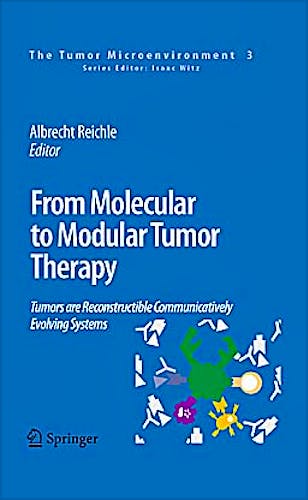

No hay productos en el carrito



From Molecular to Modular Tumor Therapy. Tumors Are Reconstructible Communicatively Evolving Systems (The Tumor Microenvironment, Vol. 3)
Reichle, A.
1ª Edición Septiembre 2010
Inglés
Tapa dura
556 pags
1300 gr
16 x 24 x 3 cm
ISBN 9789048195305
Editorial SPRINGER
About this book
The traditional problem of the poor presentability as well as diagnostic and
therapeutic practicability of individual patient care is still unresolved. The
present book aims at leading the reader (cancer researchers, pharmacologists,
biologists) away?in a scientifically accessible manner?from the daily conflicts
between theory and practice and between the generalized and individual tumor
patient, so that more personalized diagnostic and therapeutic strategies can
be developed for controlling metastatic tumor disease: • First, recording
the systems concept of tumor biology based on rather different sciences (biochemistry,
cell biology, and medical oncology) including their potential contribution to
communication, • then, giving reductionistically derived systems features
an internal communicative context (formal-pragmatic communication theory), and
• finally, binding the systems features to (tumor-immanent) evolutionary
processes (modularity of biochemical and cellular processes, rationalization
of biologic functions).
Content Level » Research
Keywords » Communication theory (integration of communication) - Evolution,
modularity - Holism-reductionism - Tumor models - Tumor-associated inflammation
Related subjects » Cancer Research - Evolutionary & Developmental
Biology - Medicine - Pharmaceutical Science
Table of contents
Introduction. 1.Bridging theory and therapeutic practice:From generalized disease models to particular patient. Part I; Therapy-derived systems biology: A pragmatic communication theory. 2. Tumor systems need to be rendered usable for a new action-theoretical abstraction:The starting point for novel therapeutic options. 3. Principles of modular tumor therapy. Part II; Tumors share common processes during tumor evolution:Communicative aspects of a situation’s interpretationfor creating systems-directed therapies. 4. Coagulation Cancer and Coagulation; focusing on tissue factor and heparanase. 5.The role of mesenchymal cells in cancer: contribution to tumor stroma and tumorigenic capacity. 6. Shaping Tumour Associated Macrophages: The Role of NF-?B. 7. The metabolic Achilles heel: tumor cell metabolism as therapeutic target. 8. Could be systems-directed therapy approaches promising in glioblastoma patients?. Part III; Systems-relevant molecular and cellular targets:Implementation of modular ‘knowledge’(Integration of communication). 9. Functional impacts of signal integration: Regulation of inflammation-related transcription factors by heterotrimeric G proteins. 10. Molecular cross-talk between nuclear receptors and nuclear factor-?B. 11. The biomodulatory capacities of low-dose metronomic chemotherapy: complex modulation of the tumor microenvironment. Part IV; Tumors are evolvable modular and rationalized systems:From molecular to modular tumor therapy. 12.Systems biology: A therapeutic target for tumor therapy. 13. The comparative uncovering of tumor systems biology by modularly targeting tumor-associated inflammation. 14. Searching for the ‘metabolism’ of evolution. Part V. Biomodulatory therapy approaches in metastatic cancer. 15. Therapeutic inflammation control may impact pathways ultimately determining outcome. 16. Cholangiocellular carcinoma. 17.A secretome-derived biomarker, C-reactive protein as response parameter to biomodulatory therapy in metastatic renal clear cell carcinoma. 18. Modular therapy approach in metastatic castration-refractory prostate cancer. 19. Systems-directed therapy inmetastatic castration-refractory prostate cancer. Part VI; Criteria for checking systems behavior and creating predictions: Systems-associated biomarkers and molecular imaging. 20.Early detection of systems response: Molecular and functional imaging of angiogenesis. 21. The secretome, a novel tool of biomarkers for guiding biomodulatory therapy approaches. 22. Systems-associated prognostic biomarkers: A ‘late-stage’ biomarker. Part VII; harmacological considerations on systems biological therapy approaches. 23. Uncovering tumor systems biologyby biomodulatory therapy strategies. 24. Breathing new life into old drugs: Indication discovery by systems-directed therapy. Part VIII; Tumors’ systems biology: Implications for personalized therapy. 25.A methodologically guided approach for personalized therapy in metastatic cancer. Part IX; Summary. 26.From theme-dependent to evolution-adjusted tumor therapy.
© 2025 Axón Librería S.L.
2.149.0